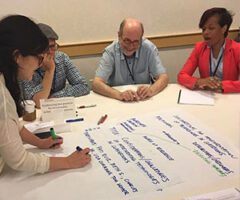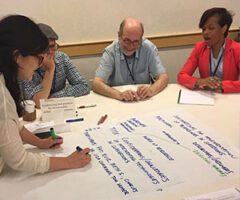The 5th annual Cyberlearning meeting, recently held in Arlington, VA, engaged more than 180 NSF-funded researchers, educators and other attendees, including NSF and OSTP leadership, in highly interactive discussions aimed at tackling problems in learning — problems that are bigger than any one research team could solve on its own. Keynotes and other sessions from the meeting are now available for viewing, as is a Twitter-based story that captures highlights and the interactive spirit of the event.

The first keynote speaker, Nichole Pinkard, raised the issue of city-scale learning—learning that is coherently supported across school, home, and community settings. Technology is now enabling smart cities, but can we use technology in smart ways to expand city-scale youth development? Pinkard shared the successes of the Chicago City of Learning and Digital Youth Network and called for deeper engagement of researchers in developing innovations to foster youth engagement in learning even in the face of school budget cuts.
The second keynote speaker, Peggy Weil, shared her explorations of immersive journalism and public data visualization. An interactive digital artist, Weil showed how virtual reality could transform journalism by enabling a sense of presence, empathy, and engagement in complex news stories. She also inspired attendees with her project to transform the skyscraper-sized displays in New York’s Times Square into opportunities for learning about the science related to water shortages.
Highlights of the second day included talks by Jim Shelton and Linda Chaput. Jim Shelton will lead education efforts for the new Chan Zuckerberg Initiative and his keynote challenged the assembled cyberlearning innovators to create assessments that would be accurate, but not interfere with the joy of learning. Likewise, he emphasized the need to support students’ persistence in learning — a challenge that requires focused, interdisciplinary work from social and computational scientists.
Shelton celebrated that “Everyone in this room is all about LEARNING, building on capabilities of new technology” but challenged the community to translate their research into tools that are easy for schools to adopt. Linda Chaput, CEO of AgileMind followed strongly upon this remark. Her keynote addressed how a technology platform can simultaneously serve the everyday needs of a million, high-need STEM students and their teachers through an easy-to-use interface, while simultaneously and continuously integrating new data science and learning science insights to achieve a vision of improving teaching while enabling students to take responsibility for their own learning.
The real action at Cyberlearning ‘16, unlike a typical conference, was not in large-format presentations but in intense, interactive sessions among small groups of interdisciplinary researchers. Attendees got to know each other’s work in roundtable discussions, “speed dating” ice-breakers, and poster and demo galleries. They shared knowledge in expertise exchanges on topics like:
- Smart and connected learning communities
- A shared platform for learning scientists to work with 50,000 students
- Making learning technologies accessible to students with disabilities
- How to enable students to learn data science
- Educational innovations with virtual reality
The researchers and other attendees then joined specific working sessions on both days to advance the cyberlearning community’s work. These sessions went into depth on important research concepts including how students develop their identity as STEM learners and devising research strategies to better measure important learning outcomes. The sessions also considered how to advance the technology side of cyberlearning, for example, how to combine data from different sensor types to better study learning, and how to advance virtual reality platforms so that they can support innovation in learning. Some sessions also focused on scientific communication: how this group of scientists, researchers, and educators could better share the results of their investigations with educators and the public. Many of these sessions resulted in action plans that will enable the groups to continue working together on common goals, such as submitting a capacity-building grant, conference session, or writing a primer for the CIRCL website.
Cyberlearning ‘16 is sponsored by the National Science Foundation and was organized and facilitated by the Center for Innovative Research in Cyberlearning (CIRCL). SRI International leads CIRCL, in collaboration with EDC and NORC.



